Requirements for masonry composition
For a classic Russian stove, a solution was used in which a combination of heat resistance, increased heat capacity and a coefficient of thermal expansion equal to that of a brick was taken into account. Such a solution was made on the basis of oily clay.
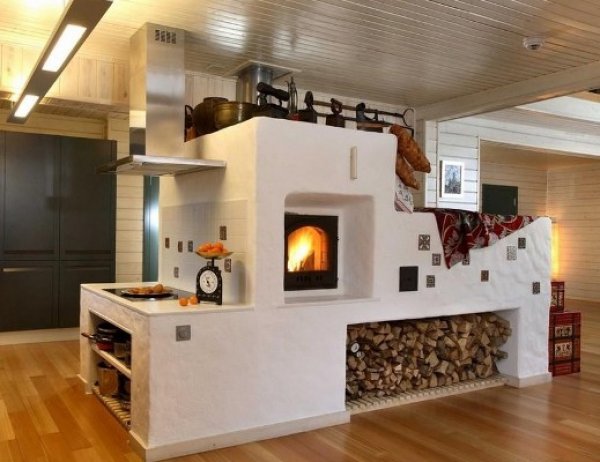
Photo 1. Classic Russian wood-fired stove. Equipped with a firebox and cooking area.
Nowadays, dry ready-made mixtures, certain types of clays, and other substances used in laying are sold. Construction and repairs are simplified with their help. But not all ready-made building mixtures initially have the necessary characteristics, such as:
- fire resistance;
- heat resistance;
- gas tightness.
Refractory mixtures refer to either refractory or refractory compounds that are adapted to prolonged contact with fire and can withstand the action of the reactive components contained in the thermal decomposition products of the fuel.
Heat-resistant is a material that can withstand heating to a maximum temperature, while retaining its strength. Its structure and shape does not change after cooling. Heat-resistant materials include, for example, fireclay bricks. The heat-resistant solution must include clay.
The gas density must be high. The flue gases will not pass through the seams, but at the same time the finished mixture allows moisture to pass through, that is, the oven “breathes”.
Characteristics and properties
- The main characteristic of masonry mixtures is the temperature at which all refractory properties are preserved. For the mixture "Stove", this figure is 900 degrees Celsius, provided that all instructions for use and storage conditions are observed.
- The maximum time for using the solution is 90 minutes, after which it hardens and further work becomes impossible.
- In the case of applying the mortar with hand tools, the layer thickness can be varied in the range from 4mm to 15mm.
- The approximate consumption of the mixture per 1 square meter is 1.5kg-2kg, indirectly depends on the degree of unevenness of the treated surface.
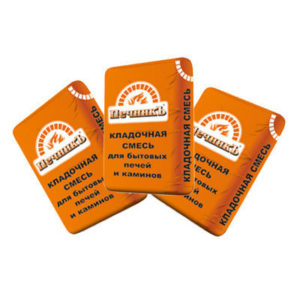
How to use it correctly?
Dilution of the mixture
Before starting work, make sure that the air temperature is within the permissible range of values from +5 degrees Celsius to +25 degrees. Prepare a clean container with free access to the contents, then pour the dry mixture into it and dilute with water in a ratio of 1 to 5. Water should be added gradually, thoroughly mixing the resulting mass.
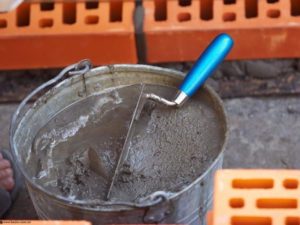
Preparation of the mixture
For the highest quality mixing and achieving a homogeneous mass, it is advisable to use a construction mixer. The water temperature is 10-25 degrees. After the initial mixing, it is recommended to leave the mixture for 10-30 minutes and repeat the mixing procedure again. The finished solution will be usable within an hour and a half.
Carrying out works
After the composition has acquired plasticity and the required consistency, you can start working. The mass is applied to the horizontal plane of the brick and is evenly distributed by translational movements over the entire surface. For maximum adhesion, you can soak the brick in water for a short time, about 10-15 seconds.
With this method, dust that interferes with contact is washed off the surface, and the extraction of moisture from the solution is slowed down. The width of the seam and the thickness of the layer of the composition are selected empirically based on the front of the upcoming work. When installing subsequent bricks, the mortar is applied not only to the back side of the brick, but also to the side edges for reliable bonding on all sides of the surface.
The plaster is applied in several layers until the required layer thickness is reached. The first layer is usually with a heavy-bristled brush and the subsequent layers with a trowel. The most optimal plaster performance is from 4mm to 1.5 centimeters.

Application of the mixture

Brick laying
The preparatory stage of work is extremely important: cooling of the room, high humidity and drafts are not allowed. Mechanical influences on the masonry during the drying period are also unacceptable. The first tests of stoves and fireplaces after installation are allowed to be carried out no earlier than on the seventh day.
By lighting a small fire and preventing a rapid rise in temperature, the technician inspects the seams for smoke leaks. It is advisable to shorten the duration of the initial heating to one hour to avoid uneven drying. Full work with the stove / fireplace is possible 2-3 weeks after the initial tests.
Solution preparation method
- To obtain a high-quality solution, the heat-resistant mixture must be thoroughly mixed with water. To obtain the desired consistency of the solution, add about 250 - 300 ml of water per 1 kg of dry mixture. Mixing the mortar is best done with a construction mixer. Using a mixer will allow you to get a more homogeneous and plastic mass.
- The prepared solution should be left to stand for 15 - 20 minutes. Then you can start working. For one "batch" should be prepared such an amount of solution that it can be consumed in one hour. Re-mixing of the hardened mortar is not desirable, this can deteriorate the quality of the masonry.
- You can check the quality of the solution in the "old-fashioned" way. Having collected a certain amount of solution on the trowel, it should be quickly turned over. If the mortar does not fall off immediately but slides along the plane of the trowel at some tilt, then you have got the “correct consistency.
- To ensure high-quality joints, the bricks must be abundantly moistened before applying the "terracotta" mortar. Otherwise, they will intensively absorb water from the solution and this will complicate the masonry process. The thickness of the joints when laying bricks should be 8 - 12 mm. The consumption of the building mixture depends on the thickness of the seams. Roughly, we can say that a twenty-kilogram bag is enough for stacking from 50 to 70 standard single bricks.
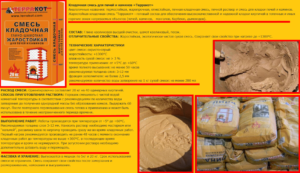
Photo instructions for use
Application Tips
When carrying out work with your own hands, everything should be carefully prepared. Containers and mechanical devices will be needed. The base must be cleaned of dirt, dust and foreign particles.
It should be noted that the mixture is prepared in such an amount that it is enough for an hour of work. After this period of time, the composition begins to harden, losing its properties. Fireclay solutions can be used within 40 minutes, and lime compositions - within 24 hours.
The masonry mix retains liquid well, so there is no need to wet the base before working with it.

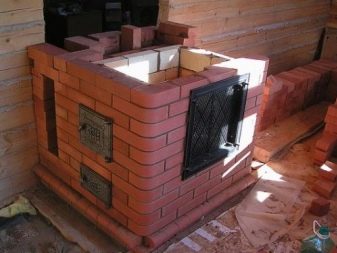
The layer of the mixture to be applied should not exceed 10 mm. When designing chimneys, especially the part that faces the street, as well as when laying the foundation, it is not recommended to use clean clay mortar, since the substance quickly collapses under the action of vapors. In this case, a mixture with the addition of lime and sand is suitable.
When adding clay to the mixture, it is necessary to take into account the degree of its fat content. To check the quality, you can try to roll a thick strip of damp material.
Then you need to carefully try to stretch it. The formation of torn surfaces will indicate the content of a large amount of sand - it is better not to use such material
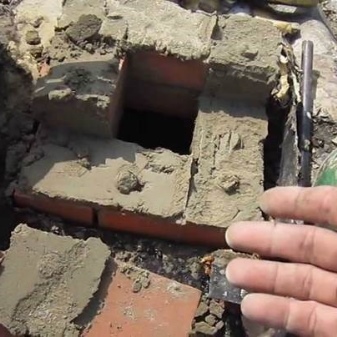
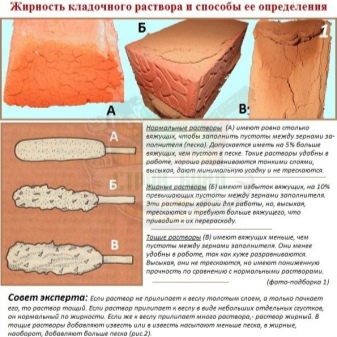
You can use a stirring tool to check the quality of the clay. When a substance adheres to a surface, the clay is considered to be oily.If after a while a liquid appears on the surface of the clay, then the substance contains too much sand.
A mixture based on low-quality clay can soon lead to deformation, destruction of brickwork, as well as surface shrinkage.
After laying the stove or fireplaces, you can start the firebox no earlier than three days later. This time is necessary for the mixture to completely harden. Facing brick masonry can be done only after a month of using heating structures, and the heating of the furnace must reach a temperature of at least 300 degrees within an hour.


When using the solution, you should follow the instructions for use. Strict adherence to the sequence of actions will ensure a positive result and high quality of the exploited surface.
1 Why is it prohibited to use a faulty oven?
The oven can fail for various reasons. Sometimes it is easier not to cover up the defects that appear, but to re-shift the oven. However, such drastic measures are rarely required. As a rule, the main reasons for the emergency state are shrinkage, poor-quality materials and mistakes made when laying out the hearth.
Heating systems require regular maintenance. According to the norms of SNiP, heating devices in the country must be inspected twice a year. And in a private house at least once a quarter. Unfortunately, most homeowners neglect these requirements.
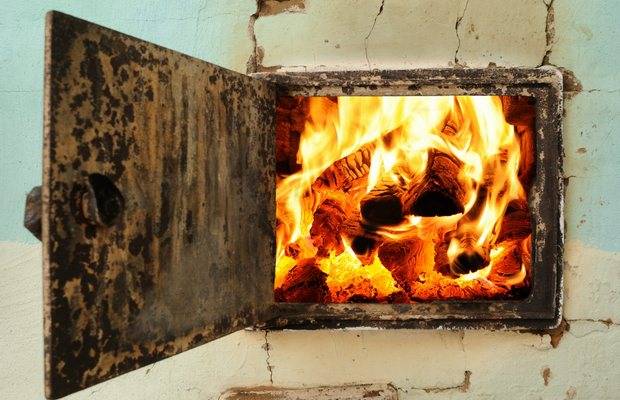
You can only use a complete oven
The main danger for the residents of the house is not the collapsed hearth, but the cracks that have appeared in it. The explanation is simple - obviously no one will heat the emergency stove, but cracks cannot always be noticed in time. Carbon monoxide that seeped through them is a serious danger for the inhabitants of the house. According to statistics provided by the Ministry of Emergency Situations, in a fire, 70% of people die from smoke, and of those who survived, 42% end up in hospital with carbon monoxide poisoning.
Mixtures for the device of individual elements of the furnace
There are two main requirements for kiln mixtures: thermal stability and elasticity. These qualities will allow you to fully operate the device without fear of the formation of chips and cracks at the time of heating. Mortars are made based on components such as cement, lime, gypsum, etc. There are also mixed formulations with several binders. For each individual part of the fireplace, you need to select the appropriate mixture:
- the foundation is erected using a lime-based material or a cement-lime component. If it is too wet under the base, then use cement-based mixtures;
- the chimney is laid out on lime or lime-gypsum mortar. To make the mixture harden faster, you can add gypsum to it;
- the building is constructed from a mixture of sand, clay and water.
If any of these elements require increased strength, cement must be added to the main composition.
Kiln brick
Usually, two types of bricks are used - these are fireclay or ceramic refractory bricks. If the stove is built in a bathhouse, then fireclay bricks are no longer suitable here, ceramic refractory and clinker ones are used.
By components, the structure can be divided as follows:
- foundation;
- facing;
- firebox;
- chimney;
- smoke circulation.
First-class bricks are needed on the foundation, clinker bricks are best used in a region with constant and severe frosts. The mortar in this case is suitable for lime or cement, it has good strength.
The firebox itself should be laid from fireclay bricks, the solution is similar - fireclay.
The chimney is equipped with refractory bricks, a composition with clay is used.
The chimney is built of grade 1 bricks or clinker bricks in combination with hollow bricks (in places with a harsh climate).
Stove plaster repair
Cracks can form as a result of improper furnace design (uneven heating of nearby zones), too high a temperature, loosening in the door area, improper plastering. In the first case, it will be necessary to re-lay the stove, in the second - fire-resistant, heat-resistant plaster for stoves and fireplaces (or adding chamotte powder to clay), in the third - strengthening the structure with a mesh. In general, repairs are required.

How to cover up the stove if re-laying and removal of the old coating is not required? Algorithm of actions:
- We clean the surface from whitewash.
- We use a chisel to clear an area with a crack to bricks.
- We clean the surface with a metal brush.
- Apply the primer with a brush (you can dilute the cement with water).
- We make a batch. For smearing, it is better to use a composition close to your own.
- We apply the mixture to the area, wetting it in advance. Put the mixture on the stove in small portions and mash.
- Dry.
Loose doors, valves are removed, we clean the place. We make holes for fasteners, wedge the ends of the wire. We wrap the door frame with asbestos cord, put it in place, fix it with wire. We finish by applying the clay composition.
Now that you have learned how to plaster a stove, which composition is better to choose, you can plaster a new stove with your own hands or repair the coating of an old stove. To expand our understanding of the plastering process, we suggest that you familiarize yourself with the articles of the Types of Plastering and Plastering sections.
Clay based
One of the cheapest and most affordable types of joint kiln mixes. Clay mortar for masonry ovens is characterized by increased fat content, which determines the degree of plasticity, heat resistance and strength of the finished material.
A solution for a stove made of natural clay is:
- Bold - differs in plasticity, strength, but the rapid appearance of cracks after drying;
- Normal - quite flexible and resistant to cracking, gives a small percentage of shrinkage after drying. Able to withstand high temperatures up to 110 degrees;
- Skinny - non-plastic and short-lived, susceptible to rapid delamination and crumbling.
A clay refractory mortar is prepared on the basis of three components: clay, sand and water. Such a composition is resistant to cracking and drying out, provides a reliable arrangement of a brick oven.
To build a stove maker, it is recommended to use fatty and normal compounds that have increased strength, plasticity and resistance to delamination.
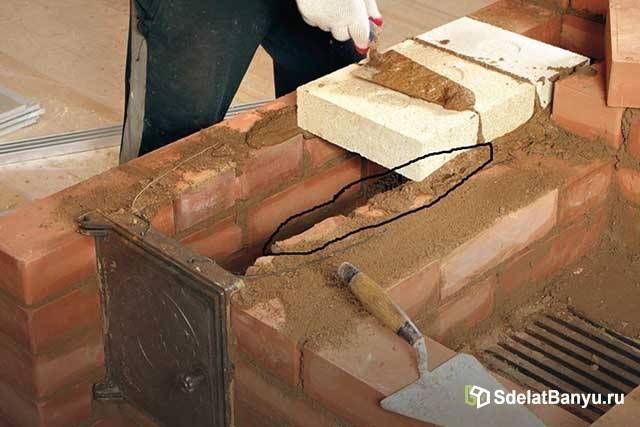
The quality of the clay determines the amount of sand required to mix the mortar. For work, clay and purified water with a low content of impurities is used. For laying 100 bricks, on average, up to 20 liters of clean water are used.
For the preparation of the solution, quarry or river sand of fine fraction is used without additional impurities. Before use, it must be sieved through a fine mesh sieve. If it contains impurities of gravel, then it is recommended to use a sieve with a mesh size of up to 10 mm. For fine material, a sieve with 2 mm meshes is suitable.
Before adding other components, it is recommended to test the clay base for plasticity. How do you make this check? To do this, a small board should be dipped into the resulting mixture for laying the oven and its thickness should be determined. It should be moderately thick and viscous. If there is excess liquid, then it is worth adding a little astringent component, stirring occasionally and testing the mixture for plasticity.
The optimum thickness of the connecting material is 2 mm, which indicates the correct observance of the proportions of all components. The finished masonry mass is viscous and not very dense.
The appropriate density of the mortar for masonry depends on the ratio of the main components in it - clay and sand, respectively:
- Fatty mass - 1: 2;
- Normal weight - 1: 1;
- Lean mass - 2: 1.
Methods for preparing clay composition
How to prepare a high-quality clay-based joint compound? There are several proven methods.
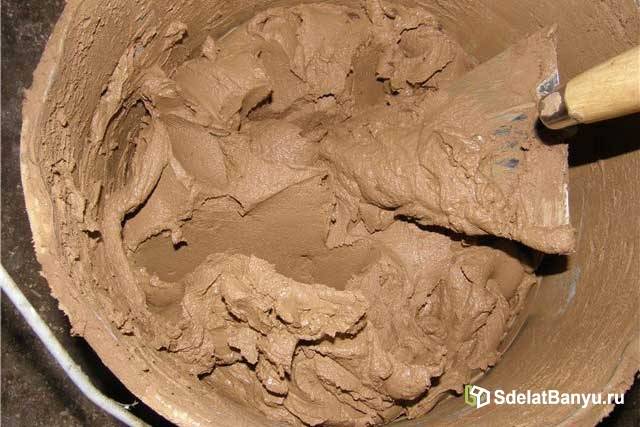
The required volume of clay is soaked for 24 hours, water is added to obtain a thick mass. The resulting material is carefully filtered, then sand is added to it and kneaded again
Chamotte sand and clay are combined in the container in equal proportions, purified water is added (1/4 of the clay volume). All components are thoroughly mixed until a homogeneous mass is obtained.
The composition is kneaded on the basis of loams. This recipe provides for the preparation of 10 different options for the solution, from which the best is selected.
For the first: 10 volumes of loam, 1 volume of sand and 1 volume of cement, etc. in descending order of volume of loam. Ten obtained bases are placed in different containers and left to dry for 5-6 days. At the end of the allotted time, the most qualitative composition of the solution with a minimum degree of shrinkage and resistance to cracking is determined.
4 Features of repairing furnaces using fireclay clay
Often, fireclay clay is used in the construction and repair of brick kilns. After heat treatment, this rock receives additional properties. For the manufacture of chamotte, kaolin clay is used. In the course of heat treatment (+1500 degrees), it turned into stone. The resulting stone powder is added to the composition of the solution during the repair or construction of the furnace.
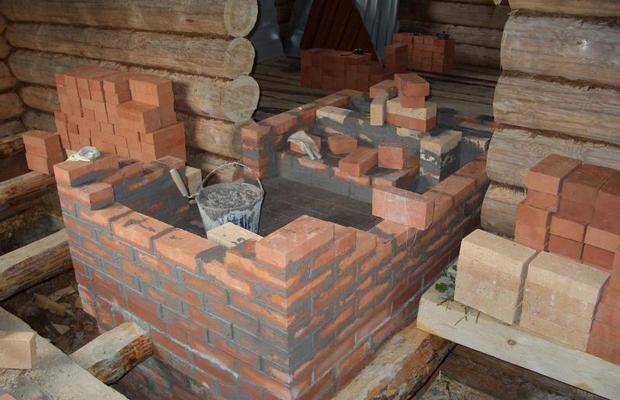
Follow all recommendations when repairing the oven
Fireclay differs from similar materials in the following advantages:
- resistance to high temperatures,
- vapor permeability,
- high adhesive properties.
In addition, fireclay clay is safe for human health and will ensure a long service life of the hearth. Unfortunately, there were some negative qualities.
Chamotte does not occur in nature, and the kaolin clay, which underlies it, is a rather rare material. Unsurprisingly, the main drawback of this material is the price. The second nuance is that chamotte does not tolerate a humid atmosphere poorly. Therefore, in order to properly cover the stove, you need to use other materials (cement, quarry sand).
A chamotte finishing mixture for repairing a hearth is created in the following proportions: 7 parts of sand, 1 cement and 2 parts of clay. The amount of water is selected individually. The proportions may vary slightly, but this particular combination is considered the best.
The main options for mixtures for laying a fireplace
It is necessary to understand that the construction process involves three main stages:
- foundation preparation:
- laying of the main array;
- external finishing.
The corresponding stage will require a different mixture, although you can use universal options.
To fill the foundation, a concrete solution is needed: for one part of the cement, three parts of sand are taken and diluted with water to a state similar to wet earth. You can add fine crushed stone.
Such a solution is not sold ready-made; it must be prepared immediately before pouring the base. The setting of the solution will begin in half an hour, and the final hardening after a day. Further, you can proceed directly to laying brick or stone.
This process requires a refractory masonry mixture, which will contain chamotte, a special type of heat-resistant clay. It can be bought ready-made and diluted with water to the desired consistency, you can make it yourself, which will save money, but will require more time and responsibility.
The preparation of the plastering solution can be carried out using lime. This option is quite widespread. Components:
- lime;
- water;
- gypsum or cement.
Lime must be carefully sieved so that there are no stones and large seals, since such inclusions cannot completely dissolve, and when they dry, "shoot", which will negatively affect the final result.
Cement or gypsum is added to make the plaster more durable, but you can do without them. First, mix the dry ingredients, then add water in small portions. The lime will begin to be extinguished by dissolving.
Types of plaster
In the process of burning fuel, the fire heats the structure, for this reason, it requires a finish that is distinguished by high-temperature performance. It is necessary that heat-resistant plaster for stoves and fireplaces has certain properties. You can prepare such a mixture with your own hands.
For the construction of an effective hearth in a house, it is necessary to have many years of experience in such work, because the safety of people depends on how well the smoke removal is arranged. But after the structure has been professionally erected, you can give it a complete appearance yourself. For this, a plaster mixture for stoves and fireplaces is applied to it.

Of the properties that the plaster should be characterized by, first of all, it should be noted resistance to high temperatures, since the unit will be very hot. The refractory composition for stoves is a mixture that includes a special heat-resistant component that gives their outer coating elasticity and strength at the same time, and protects against moisture, mechanical damage and cracking.
After using a special heat-resistant plaster for stoves and fireplaces, you should not be afraid that high temperatures will damage the appearance. In building stores on sale there are universal mixtures designed for outdoor and indoor finishing work. But they are not suitable for fireplaces, since they do not have the required heat resistance.
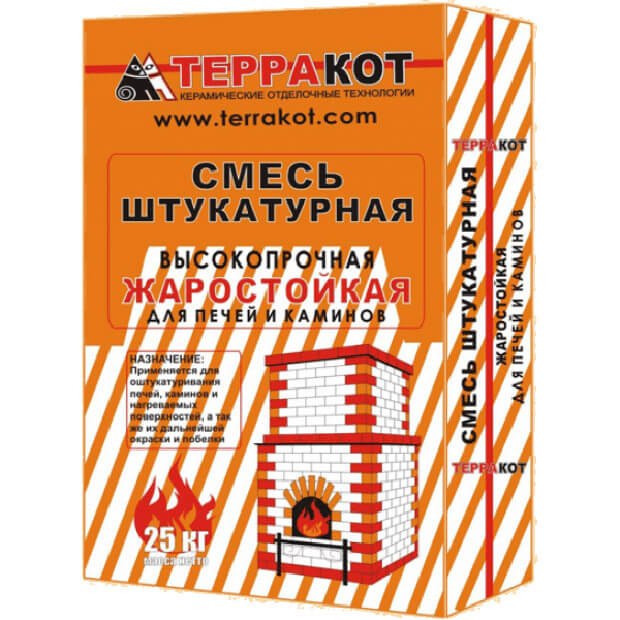
For these purposes, ready-made high-temperature compositions in dry form for plastering are suitable: "KREATIVPUTZ", "ARMIERUNGSPUTZ", "Pechnik", "Terracotta", as well as refractory concrete "Rath CARATH". All these mixtures differ from the usual content of impurities, such as quartz sand, chamotte clay, glass and cement aluminate, which allow the plaster to withstand temperatures reaching 1200-1700˚С.
Features of the preparation of working solutions
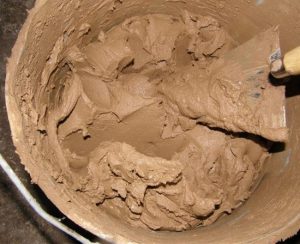 Regardless of the selected composition of the refractory mixture, the master will need water in any case. It should not contain a large amount of hardness salts - calcium and magnesium bicarbonates.
Regardless of the selected composition of the refractory mixture, the master will need water in any case. It should not contain a large amount of hardness salts - calcium and magnesium bicarbonates.
Usually, the population knows the peculiarities of local water, the location of sources with water of low hardness. If necessary, you can slightly soften the water using special methods, but it is advisable to do this only as a last resort, since the pleasure will be expensive.
For DIY masonry of all parts of the furnace, white sand, which has a quartz composition, is ideal. Sandy grains of yellowish color can be used for laying any parts of the furnace structure, except for the furnace.
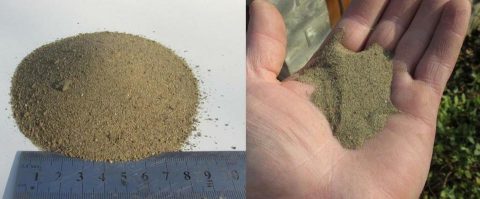
There are long-standing historical methods for determining the amount of sand to add to clay. The ancestors lived a leisurely measured life, so the mixtures were tested for more than 3 weeks. Now people make the check faster - they prepare several versions of cakes or balls, wait for complete drying, then drop them onto a wooden surface from a height of one meter. Worthy of attention is the composition that did not split. If there are several such resistant samples, the height for the test can be increased; in the bed, choose the most durable option.
The final control check can be carried out as follows: grease a wide part of the brick (bed) with a layer of mortar of at least 3 mm with a ready-made mixture, lay the second brick on top, press it well by tapping it with a wooden handle, wait 10 minutes and raise it.If the bottom brick is held and does not fall, the composition is suitable.
Initial operation of the oven
The use of high-quality materials (brick, mortar) does not guarantee long-term and reliable functioning of the stove or fireplace, if they are incorrectly “put into operation”. The fact is that solutions based on kaolin clay dry for a long time. Therefore, the first furnace must be made no earlier than three days after the end of the work.
Do not load the maximum amount of fuel during the first fire. It is necessary to load the stove to 60 - 70% and heat for 5 - 8 hours. At the initial stage of operation, you should continue to heat the stove in a gentle mode. With prolonged heating, the seams will be hardened due to sintering of kaolin clay, and the structure will acquire the necessary strength.
Sometimes, after the first furnaces, a white bloom may appear on the brick in areas of strong heating. This should not be feared. For the first times, the plaque is removed with a damp cloth, and then, as the oven warms up, the appearance of plaque will stop.
One more tip. Before finishing work, plastering or overlaying with finishing stone, tiles, the stove needs to be operated for several weeks.
